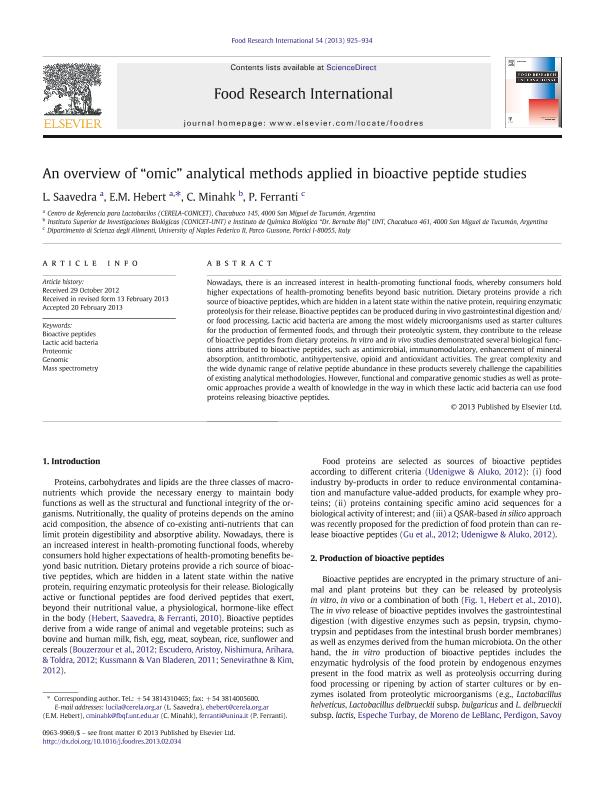Mostrar el registro sencillo del ítem
dc.contributor.author
Saavedra, Maria Lucila

dc.contributor.author
Hebert, Elvira Maria

dc.contributor.author
Minahk, Carlos Javier

dc.contributor.author
Ferranti, Pascuale
dc.date.available
2015-10-06T20:46:03Z
dc.date.issued
2013-03
dc.identifier.citation
Saavedra, Maria Lucila; Hebert, Elvira Maria; Minahk, Carlos Javier; Ferranti, Pascuale; An overview of "omic" analytical methods applied in bioactive peptide studies; Elsevier Science; Food Research International; 54; 1; 3-2013; 925-934
dc.identifier.issn
0963-9969
dc.identifier.uri
http://hdl.handle.net/11336/2375
dc.description.abstract
Nowadays, there is an increased interest in health-promoting functional foods, whereby consumers hold higher expectations of health-promoting Benefits beyond basic nutrition. Dietary proteins provide a rich source of bioactive peptides, which are hidden in a latent state within the native protein, requiring enzymatic proteolysis for their release. Bioactive peptides can be produced during in vivo gastrointestinal digestion and/ or food processing. Lactic acid bacteria are among the most widely microorganisms used as starter cultures for the production of fermented foods, and through their proteolytic system, they contribute to the release of bioactive peptides from dietary proteins. In vitro and in vivo studies demonstrated several biological functions attributed to bioactive peptides, such as antimicrobial, immunomodulatory, enhancement of mineral absorption, antithrombotic, antihypertensive, opioid and antioxidant activities. The great complexity and the wide dynamic range of relative peptide abundance in these products severely challenge the capabilities of existing analytical methodologies. However, functional and comparative genomic studies as well as proteomic approaches provide a wealth of knowledge in the way in which these lactic acid bacteria can use food proteins releasing bioactive peptides.
dc.format
application/pdf
dc.language.iso
eng
dc.publisher
Elsevier Science

dc.rights
info:eu-repo/semantics/openAccess
dc.rights.uri
https://creativecommons.org/licenses/by-nc-sa/2.5/ar/
dc.subject
BIOACTIVE PEPTIDES
dc.subject
GENOMIC
dc.subject
LACTIC ACID BACTERIA
dc.subject
MASS SPECTROMETRY
dc.subject
PROTEOMIC
dc.subject.classification
Biología Celular, Microbiología

dc.subject.classification
Ciencias Biológicas

dc.subject.classification
CIENCIAS NATURALES Y EXACTAS

dc.title
An overview of "omic" analytical methods applied in bioactive peptide studies
dc.type
info:eu-repo/semantics/article
dc.type
info:ar-repo/semantics/artículo
dc.type
info:eu-repo/semantics/publishedVersion
dc.date.updated
2016-03-30 10:35:44.97925-03
dc.identifier.eissn
1873-7145
dc.journal.volume
54
dc.journal.number
1
dc.journal.pagination
925-934
dc.journal.pais
Países Bajos

dc.journal.ciudad
Amsterdam
dc.description.fil
Fil: Saavedra, Maria Lucila. Consejo Nacional de Investigaciones Científicas y Técnicas. Centro Científico Tecnológico Tucumán. Centro de Referencia Para Lactobacilos (i); Argentina
dc.description.fil
Fil: Hebert, Elvira Maria. Consejo Nacional de Investigaciones Científicas y Técnicas. Centro Científico Tecnológico Tucumán. Centro de Referencia Para Lactobacilos (i); Argentina
dc.description.fil
Fil: Minahk, Carlos Javier. Consejo Nacional de Investigaciones Científicas y Técnicas. Centro Científico Tecnológico - Conicet - Tucumán. Instituto Superior de Investigaciones Biológicas; Argentina. Universidad Nacional de Tucuman. Facultad de Bioquimica, Quimica y Farmacia. Instituto de Quimica Biologica; Argentina
dc.description.fil
Fil: Ferranti, Pascuale. Università degli Studi di Napoli Federico II; Italia
dc.journal.title
Food Research International

dc.relation.alternativeid
info:eu-repo/semantics/altIdentifier/doi/http://dx.doi.org/10.1016/j.foodres.2013.02.034
Archivos asociados
